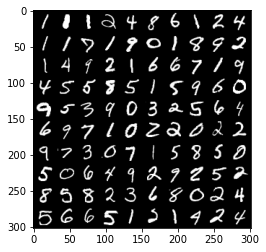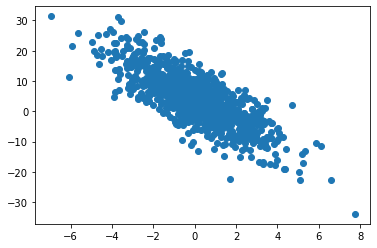梯度下降/上升
import matplotlib.pyplot as plt
import numpy as np
X = np.linspace(-np.pi, np.pi, 256, endpoint=True)
C = np.cos(X)
plt.plot(X,C)
plt.show()

对于上面的一个凸函数,如何不知道函数的表达式,或者表达式难以求导 需要对其求最大值,可以使用梯度上升法一步一步沿着梯度求最大值
K = np.append((X*(X+1))[:64*3], (X*(X+1)-10)[64*3:])
plt.plot(X, K)
plt.show()

但对于某些奇怪的函数,例如上面,梯度下降可能会陷入局部最优解
- 梯度下降/上升也是属于一种贪心算法,容易陷入局部最优
步骤
- 随机找一个初始值 $w _ 0$
- 按照 $\mathbf{w} _ {t} = \mathbf{w} _ {t-1}-\eta \frac{\partial \ell}{\partial \mathbf{w} _ {t-1}}$ 来重复迭代参数t
其中 $\eta$ 是学习率, $ \frac{\partial \ell}{\partial \mathbf{w} _ {t-1}}$ 是 $loss$ 损失函数的梯度
Learning rate
简称 lr
-
lr 是一个超参数,需要在训练模型之前定义
-
lr 不能太大,也不能太小 (经典的超参数性质)
-
大了就步子迈大了,容易扯着蛋(
-
太小 epochs 得往上拉才能训练出一个合适的模型
合适的 lr
小批量随机梯度下降
- 结合批量梯度下降和随机梯度下降,是梯度下降算法中默认的求法
- 完整的跑一遍训练集代价太大
- 所以每次训练都随机从训练集中抽取小批量来训练,可以提升训练速度
- 随机采样 n 个样本 $i _ 1, i _ 2, i _ 3, ...., i _ n$,计算损失的平均值 $\frac{1}{n} \sum _ {i \in I _ n} \ell(\mathbf{x} _ i, y _ i, \mathbf{w})$
其中 n 也是一个超参数
n 不能太大,太大内存消耗更多,样本有一定概率相同的话,大批量会使得重复计算的可能性上升
n 不能太小,太小不适合GPU进行并行计算优化
优化
数据向量化
$\mathbf{w} _ {t}=\mathbf{w} _ {t-1}-\eta \frac{\partial \ell}{\partial \mathbf{w} _ {t-1}}$ 中 $\mathbf{w}$ 可以是影响 $loss$ 的一个标量参数,如果 $\mathbf{w}$ 可取 $\mathbf{w} _ 0, \mathbf{w} _ 1, \mathbf{w} _ 2,...,\mathbf{w} _ n$,可以将 $w$ 向量化成一个向量 $[\mathbf{w} _ 0, \mathbf{w} _ 1, \mathbf{w} _ 2,...,\mathbf{w} _ n]^T$
lr = 0.03
num_epochs = 5
grads = np.array([[2.0, 1.0], [0.7, 0.4], [0.3, 0.2], [0.2, 0.1], [-0.1,-0.02]]) # 这里直接写好了梯度
def sgd(w, grad):
w -= lr * grad
w = np.array([1.0, 2.0])
for epoch in range(num_epochs):
for i in range(len(grads)):
sgd(w, grads[i])
print(f"epoch {epoch + 1} :{w}")
epoch 1 :[0.907 1.9496]
epoch 2 :[0.814 1.8992]
epoch 3 :[0.721 1.8488]
epoch 4 :[0.628 1.7984]
epoch 5 :[0.535 1.748]
获取随机小批量
import random
def data_iter(batch_size, features, labels):
num_samples = len(features)
indices = list(range(num_samples))
# 打乱索引
random.shuffle(indices)
# 确保每个 epoch 都能扫到所有的训练数据
for i in range(0, num_samples, batch_size):
batch = np.array(indices[i:min(i + batch_size, num_samples)])
features_batch = features[batch]
labels_batch = labels[batch]
# 加上 batch 大小并返回
yield features_batch, labels_batch, len(batch)
batch_size = 10
features = np.random.normal(loc=0.0, scale=1.0, size=208).reshape(104, 2)
lables = np.random.normal(loc=0.0, scale=1.0, size=104)
features[:5]
array([[ 0.73911935, -0.58917628],
[-2.1565438 , 1.47503143],
[ 0.94866773, -0.85682476],
[-0.18012857, -0.03176761],
[ 0.21976216, 0.19298218]])
lables[:5]
array([-0.95478689, -0.71763201, 0.25806049, -2.05750401, -1.51843728])
for X, y, l in data_iter(batch_size, features, lables):
print(f"features_batch: {X[0]}, labels_batch: {y[0]}, batch_size: {l}")
features_batch: [-1.45485397 -0.39236135], labels_batch: 0.12318386924794186, batch_size: 10
features_batch: [-1.43973829 0.78538624], labels_batch: -0.8234640736033031, batch_size: 10
features_batch: [0.30462236 0.07124829], labels_batch: 0.20986935899039746, batch_size: 10
features_batch: [-0.37700071 -0.20652541], labels_batch: 2.3357916154234353, batch_size: 10
features_batch: [-0.77891528 -0.9346586 ], labels_batch: -0.1957866052492824, batch_size: 10
features_batch: [-0.40627378 0.2567436 ], labels_batch: 1.0447063842774422, batch_size: 10
features_batch: [-0.23127423 0.01000124], labels_batch: -0.275188295527573, batch_size: 10
features_batch: [-0.58167182 -3.57120846], labels_batch: 1.1866751115430718, batch_size: 10
features_batch: [-1.49816488 -0.17920149], labels_batch: 0.6971271403274875, batch_size: 10
features_batch: [-0.44691797 0.03166521], labels_batch: -0.8881366562785638, batch_size: 10
features_batch: [-0.07057601 0.27185821], labels_batch: -1.0327701589004996, batch_size: 4
线性回归
主要从下面公式中求解出 $w$ 和 $b$
$y = x _ 0w _ 0 + x _ 1w _ 1 + ... + x _ {n-1}w _ {n-1} + b$
向量化后
$$ y = \begin{bmatrix} x_0 & x_1 & x_2 & ... & x_{n-1} & 1 \end{bmatrix}\begin{bmatrix} \mathbf{w} _ 0 \ \mathbf{w} _ 1\ \mathbf{w} _ 2\ ...\ \mathbf{w} _ {n-1}\ b \end{bmatrix} $$
抽象一下就是这样 $$ y = \left \langle \mathbf{X},\mathbf{w} \right \rangle $$
损失函数
$$ loss(\mathbf{X},\mathbf{y},\mathbf{w}) = \frac{1}{2n}\sum _ {i}^{n}(y _ i - \hat{y} _ i)^2 = \frac{1}{2n} \left |\mathbf{y}- \mathbf{X}\mathbf{w} \right |^2 $$
其中 $\hat{y}_i$ 是 预测值 $y_i$ 是 真实值
$\mathbf{X}$ 可以是矩阵,那么 $\mathbf{y}$ 就是向量,反之 $\mathbf{X}$ 是向量,那么 $\mathbf{y}$ 就是一个标量(数)
$\frac{1}{2n}$ 中 2 的作用是消除 L2 范数中平方导数后的影响
求导
- 对 $\mathbf{w}$ 求导
$$ \frac{\partial }{\partial \mathbf{w}} loss(\mathbf{X},\mathbf{y},\mathbf{w}) = \frac{\partial}{\partial \mathbf{w}} \frac{1}{2n} \left |\mathbf{y}- \mathbf{X}\mathbf{w} \right |^2 $$ $$ = - \frac{1}{n} (\mathbf{y} - \mathbf{Xw})^T \mathbf{X} $$
令其等于 0 求得极值点(如果有唯一解肯定是最优解点)
解得
$$ \frac{1}{n} (\mathbf{y} - \mathbf{Xw})^T \mathbf{X} = 0 \Longleftrightarrow \mathbf{w}^{*T} = \mathbf{y}^T\mathbf{X}(\mathbf{X}^T\mathbf{X})^{-1} $$
从以上推导可以看出
- 线性回归存在显示解
import numpy as np
import random
from matplotlib import pyplot as plt
true_param = np.array([2.6, -3.4, 4.2]) # 分别是 w_0, w_1, b
# 生成 y = Xw + 噪声
def noise_data(param, num_samples):
# 均值设置成 -1
X = np.random.normal(loc=-1.0, scale=2.0, size=(num_samples, len(param)))
# 构造辅助矩阵 a
a = np.eye(len(param))
a[len(param)-1, len(param)-1] = 0
# 点乘辅助矩阵, 这里将整体 + 1,补上均值 -1 的坑,将最后一个数变成 1
X = np.dot(X, a) + 1
y = np.dot(X, param)
# 加点随机
y += np.random.normal(loc=0.0, scale=0.01, size=y.shape)
return X, y.reshape((-1, 1)) # reshape 成列向量
# 定义数据集
sample_num = 1000
features, labels = noise_data(true_param, sample_num)
print(f"true_param {true_param}")
print(f"features {features[:3]}")
print(f"labels {labels[:3]}")
plt.scatter(features[:, 1], labels)
plt.show()
true_param [ 2.6 -3.4 4.2]
features [[-1.64198071 -4.62281274 1. ]
[ 4.99955694 -1.60475986 1. ]
[-1.35368658 -2.47461838 1. ]]
labels [[15.65474609]
[22.65296282]
[ 9.07303287]]

X = np.matrix(features) # 转换成矩阵计算
y = np.matrix(labels)
w = y.T * X * ((X.T * X) ** -1)
w
matrix([[ 2.60006291, -3.39991021, 4.20011877]])
- 可以直接套用公式计算出近似解
梯度下降最小化$loss$ 函数
# 定义 loss 函数 (均方损失) 评价函数
def square_loss(y_hat, y, batch_size):
# y_hat 可能是 (n,) 的张量而y 可能是 (n,1) 的张量
return (y_hat - y.reshape(y_hat.shape)) ** 2 / (2 * batch_size)
# 定义模型
def linreg(X, param):
return np.dot(X, param)
# 梯度下降优化函数
# param 是一个行向量
# lr -> 学习率, batch_size -> 批个数
def sgd(param, labels, features, lr, batch_size):
# 转成矩阵
w = np.matrix(param).T
y = np.matrix(labels)
X = np.matrix(features)
# 求梯度
grad = - (1 / batch_size) * (y - (X * w)).T * X
# 更新参数
param -= lr * np.array(grad).reshape(param.shape)
# 测试一下
lr = 0.03
batch_size = sample_num # 全部训练集
# 初始化
param_test = np.array([1.6, -0.4, 2.2])
# 评估一下未训练前的均方损失
before = square_loss(linreg(features, param_test), labels, batch_size)
# 训练三次
sgd(param_test, labels, features, lr, batch_size)
sgd(param_test, labels, features, lr, batch_size)
sgd(param_test, labels, features, lr, batch_size)
# 再评估一次
after = square_loss(linreg(features, param_test), labels, batch_size)
print(f"before loss: {before.sum()}, after loss: {after.sum()} ")
before loss: 20.79438217983131, after loss: 10.750752225581973
- 对比未训练前,loss下降了一些,但依旧很大
加上随机小批量训练
# 定义随机小批量获取函数
def data_iter(batch_size, features, labels):
num_samples = len(features)
indices = list(range(num_samples))
# 打乱索引
random.shuffle(indices)
# 确保每个 epoch 都能扫到所有的训练数据
for i in range(0, num_samples, batch_size):
batch = np.array(indices[i:min(i + batch_size, num_samples)])
features_batch = features[batch]
labels_batch = labels[batch]
# 加上 batch 大小并返回
yield features_batch, labels_batch, len(batch)
# 训练 10 次
epochs_num = 10
# 学习率
lr = 0.01
# 模型 -> 线性模型
net = linreg
# batch_size
batch_size = 10
# 定义 loss 函数
loss = square_loss
# 随机初始化
param = np.random.normal(loc=0.0, scale=0.01, size=3)
train_loss = []
def train():
# 开始训练
for epoch in range(epochs_num):
for X, y, bs in data_iter(batch_size, features, labels):
sgd(param, y, X, lr, bs) # bs 是真实的 batch_size,防止训练集合数量不是 batch_size 的整数倍
# 评估模型
train_l = loss(net(features, param), labels, sample_num)
print(f"epoch {epoch + 1}, loss {train_l.sum()}")
train_loss.append(train_l.sum())
train()
print(f"param = {param}")
epoch 1, loss 1.2065632092722889
epoch 2, loss 0.15898723733648745
epoch 3, loss 0.02137899866036004
epoch 4, loss 0.0028851708953185904
epoch 5, loss 0.00042819857542367157
epoch 6, loss 0.00010052808715963687
epoch 7, loss 5.779900635093226e-05
epoch 8, loss 5.1783731344928684e-05
epoch 9, loss 5.081713521527933e-05
epoch 10, loss 5.081523581349108e-05
param = [ 2.6003643 -3.39990574 4.19993823]
plt.plot(range(epochs_num+1)[1:], train_loss)
plt.show()

loss 在逐步下降,10 次训练后已经非常低了
- 但如果学习率取值不恰当,就会出现如下问题
# 太大
lr = 0.3
train_loss = []
param = np.random.normal(loc=0.0, scale=0.01, size=3)
train()
plt.plot(range(epochs_num+1)[1:], train_loss)
plt.show()
epoch 1, loss 6.379668827684062e-05
epoch 2, loss 7.248316610920411e-05
epoch 3, loss 7.329380803747091e-05
epoch 4, loss 6.425372957395597e-05
epoch 5, loss 7.468758571938891e-05
epoch 6, loss 7.182971239060776e-05
epoch 7, loss 7.330242279496708e-05
epoch 8, loss 0.00012583320290307138
epoch 9, loss 6.715234898209186e-05
epoch 10, loss 6.558175808855953e-05

# 太小
lr = 0.00001
train_loss = []
param = np.random.normal(loc=0.0, scale=0.01, size=3)
train()
plt.plot(range(epochs_num+1)[1:], train_loss)
plt.show()
epoch 1, loss 43.83333313218246
epoch 2, loss 43.54262935003088
epoch 3, loss 43.254090728663186
epoch 4, loss 42.967700330914276
epoch 5, loss 42.68343716053708
epoch 6, loss 42.40129499586425
epoch 7, loss 42.12124256403142
epoch 8, loss 41.84327579643957
epoch 9, loss 41.56737663520067
epoch 10, loss 41.29352752241461

- 前者loss反复横跳,后者loss居高不下
使用 pytorch 自动求导
import torch
from torch.utils import data
from torch import nn
# 定义参数
batch_size = 10
# reshape 成二维张量再乘
true_w = torch.tensor([2.6, -3.4])
true_b = 3.2
sample_num = 1000
# 得到训练集
features = torch.normal(0, 1, (sample_num, len(true_w)))
labels = torch.matmul(features, true_w) + true_b
# 加上随机噪音
labels += torch.normal(0, 0.01, labels.shape)
labels = labels.reshape(-1, 1) # reshape 成列向量
# 得到 pytorch 的 dataset
dataset = data.TensorDataset(features, labels)
dataset = data.DataLoader(dataset, batch_size, shuffle=True)
# 这样就可以拿到 X, y
X, y = next(iter(dataset))
print(X[:3])
print(y[:3])
tensor([[ 0.0210, -0.6603],
[-0.7817, -0.6642],
[-0.7901, 1.3997]])
tensor([[ 5.4977],
[ 3.4239],
[-3.6240]])
net = nn.Sequential(nn.Linear(2, 1))
net[0].weight.data.normal_(0, 0.01) # 权重
net[0].bias.data.fill_(1) # 偏差
tensor([1.])
# 损失函数
loss = nn.MSELoss()
# 训练模型
trainer = torch.optim.SGD(net.parameters(), lr=0.03)
epochs_num = 3
for epoch in range(epochs_num):
for X, y in dataset:
# 求损失
l = loss(net(X), y)
# 梯度清零
trainer.zero_grad()
# 反向传递求梯度
l.backward()
# 更新模型
trainer.step()
# 评价
l = loss(net(features), labels)
print(f"epoch {epoch + 1}, loss {l:f}")
print(f"w = {net[0].weight.data}, b = {net[0].bias.data}")
epoch 1, loss 0.000229
epoch 2, loss 0.000095
epoch 3, loss 0.000095
w = tensor([[ 2.5994, -3.3995]]), b = tensor([3.1995])
